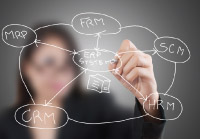A View From Above
Cloud-based Supply-Chain Software Gives Exporters the Latest Technology to Track Shipments
There are places in Africa where it is generally expected that up to 20 percent of shipments could go missing. A ship arrives at port, cargo gets unloaded onto one of several trucks which then motors off and never arrives at its destination, yet presumably comes back for more. The trucks operate in a round-the-clock continuous loop from port to factory in an effort to clear the ship and have it on its way as fast as possible, though no one knows when one of those trucks goes off route and goods are stolen. Consider this the extreme example of why tracking cargo is so important in today’s supply-chains, but knowing where your cargo is—whether it be a supplier’s inbound shipment or your own product en route to a distributor or end user—isn’t just a valuable tool, it’s a necessity for any company committed to being competitive.
In today’s world of collaborating in the cloud, there are many options for end-to-end supply-chain management software that will handle everything but spending your profits. Massive networks of suppliers, warehousers, 3PLs and transportation companies, buyers, brokers, distributors and more all converge in a hub—or in some cases, a “platform”—each adding to the tens of thousands of data points which create a visualization of the supply-chain. Variations on the software abound, but the gist remains the same: Cut down lead times by giving shippers a visualization of each link of their supply-chain, enabling them to react in real time to exception events.
And yet, at what point do you know when your latest shipment to Africa has been appropriated by undesirables? As powerful as most of the existing supply-chain management software is in providing just about every necessary service from one end to the other, widespread, true real-time tracking in-context that can actually be pinpointed on a map still represents the future.
Luckily, that future is being built by folks like Subhash Chowdary of San Jose, California-based Aankhen, Inc. Chowdary should be considered an authority on technology, having served as chief architect at Apple, created 3-D imaging of the deep underground to help geo-thermal drillers attain a 100 percent hit rate and designed more cutting-edge technology for top corporations than you could shake a memory stick at.
Today, Chowdary’s company supports specialized GPS tracking devices and sensors that are implanted with a locking mechanism onto shipping containers to report movement in real time. Now, when the container carrying your Ghana-bound goods zigs when it was meant to zag, a notification can be sent directly to your cell phone, even if it’s one of those Neolithic-generation phones with more than one button. There’s something to be said for simplicity, cutting through the noise and just saying, “If your goods deviate from their course, whether by accident, theft or act of God, you’re going to know about it immediately.”
Software giants like NetSuite see the value of this new source of real-time data and can plug Aankhen, Inc. into their supply-chain management software for those clients taking advantage of the technology. For shippers using the standard Transportation Management Systems (TMS) employed by many 3PLs, the cargo tracking aspect remains a powerful tool in visualizing one’s supply-chain. The strengths of Aankhen’s cloud-based platform—real-time reporting, elimination of human error, mapping and virtually zero on-boarding— provides visibility to the physical flow of goods across a multi-tier network of enterprises, suppliers and customers.
Tiers for Fears
Lorenzo Martinelli, senior vice president, Corporate Strategy at E2open, says that the necessity to gain visibility further down the supply-chain is largely determined by the type of product, concern over potential scarcity of individual components and high demand. He offers the example of Cisco.
“In high-tech you’ll often find that people want to go farther down in the supply chain, as far as semi-conductor products or components,” he says. “One of the longest lead items in electronics is the semi-conductor side, so for those components you sometimes want to go farther down. And then farther down there you find, at the lowest level, are the semi-con fabs, so the people who actually make silicon.”
 How deep does this type of product necessitate the visibility reaches? “In these cases we can go sometimes three to four levels down for critical components that you want to get that much visibility,” Martinelli says, adding that normal items don’t create the same challenges, but components that are very specific can create obvious challenges, especially those rare parts engineered specifically for a manufacturer.
How deep does this type of product necessitate the visibility reaches? “In these cases we can go sometimes three to four levels down for critical components that you want to get that much visibility,” Martinelli says, adding that normal items don’t create the same challenges, but components that are very specific can create obvious challenges, especially those rare parts engineered specifically for a manufacturer.
Roman Bukary, vice president and general manager of manufacturing and wholesale distribution industries at NetSuite, says the company’s supply-chain management software is “helping manufacturing companies around the world run their business inside and outside their corporate walls in the most efficient, dynamic manner possible, allowing anywhere, anytime access, complete view of the business and seamless collaboration across the entire supply network.”
The core competency of NetSuite and similar software companies is to create a visualization of a manufacturer’s supply network, allowing the company to react to changes without disrupting business. Clearly this process requires keeping tabs on more than a manufacturer’s own product; it necessitates a detailed understanding of suppliers and distributors as well. As Roman says, “[The software is] available anytime, anywhere, allowing them to figure out exactly how many of their widgets they need to build, how many widgets do they have on hand, what are the sub components that go into the production of this widget, who are their suppliers that need to feed this? We allow them to model their demand, how many items will we be selling, is there seasonality associated with this, what processes internal to our organization do we need to run to manufacture this item, what’s the overall cost and cost impact, profitability, labor, materials, direct shipment costs [and] how are we doing as a business?”
To accomplish many of the tasks associated with this tracking, the supply-chain management software providers typically turn to 3PLs and carriers, which monitor every important movement of the items they’re responsible for shipping through third-party TMS software produced by companies like LeanLogistics or MercuryGate. In the case of NetSuite, through electronic data interchange (EDI), the software will collect all data points—when this shipment leaves the port of departure, its status along the way, its arrival, etc.—and report it to the shipper through integration with its NetSuite software.
“A shipper who is running NetSuite… they go through the process of taking a customer order,” says Jon Kuerschner, senior vice president of sales and marketing at LeanLogistics. “When that order is entered into NetSuite they do the necessary credit authentication, they hit the submit button and that communicates over to the TMS solution.” The details entered include the timeline for each step of the goods’ movement and the associated costs.
From there the process is automated, unless there is any deviation, at which point changes are input and notifications sent to the users. “Any time that there’s a change to the financial impact or the timeline associated with delivering that merchandise, a notification is put back into NetSuite,” says Kuerschner. “When a customer gives us a notification of a delivery, we then close the load from a logistics perspective, recognize that there weren’t any cost discrepancies from what we entered it at and what we closed it at, and we reconcile that through the TMS. From a financial perspective, we push a final transaction record back to NetSuite saying, ‘This is what you should pay the carrier.’”
While a straight-forward GPS tracking system may promise the shortest route to tracking shipments, the power and comprehensiveness of the end-to-end supply-chain management solutions in concert with a TMS system, such as offered by LeanLogistics, provides a total solution for true visualization. Of course, processes handled by the various software solutions are wide-ranging, with some handling trade compliance, others solving broker issue and some encompassing all.
Many software companies also differ in how they collect data. Some collaborate through an online hub, most will utilize EDI, and some operate through a platform. The difference offered by “platform,” as described by Greg Kefer, vice president of corporate marketing at GT Nexus, is the technical way in which the network of service providers come together to collaborate in the cloud. The “hub” used by some software options creates a new connection and sets about tailoring each newcomer to the client. In this way, the provider is tasked with on-boarding a single supplier perhaps several times, as they are tailored to connect with a new manufacturer, for instance. Each subsequent on-boarding process for the same supplier’s connection with a new manufacturer may be easier because the provider has a body of work as a head start, but is still obligated to fill in the gaps. GT Nexus feels it has developed a more efficient method, which Kefer describes as being similar to LinkedIn. Once a supplier, transportation company or any service provider along the supply-chain has been set up on their system, he says, they’re ready to operate with all other companies on their GT Nexus platform.
“All the top 50 ocean carriers are fully wired into GT Nexus and operating today,” says Kefer. “When you come to GT Nexus and say ‘Here are the nine carriers I work with,’ they’re there. It’s not like we have to integrate anything. And they don’t have to change anything, because they’re hooked in. There’s a time-to-market benefit, because you don’t have to wire your own electric grid, their grid’s there. You just have to plug in.”
All this leaves out a rather obvious question: How can any software create visibility of the supply-chain if the data is incomplete or sub-par? This is a consideration that software provider Amber Road has gone to great lengths to ensure doesn’t interfere with the real life application of its Supply Chain Visibility software.
“It’s the rigor of the processes and data that really result in a success,” says Scott Byrnes, vice president of marketing at Amber Road. “You’re talking about collaborating with a bunch of your trading partners, and those communications can vary widely as far as the type of data they would be expected to exchange and their capability to provide it.” Part of the challenge is to normalize information coming from various countries with differing currencies, or use different short-hand for a port, for instance. But that’s the easy part.
“You might be missing quantity on shipment, or the date field may not be correct or any number of things might be missing,” says Byrnes. “You might be missing the invoice number off of the shipment data. So if it’s missing any of that info, depending upon how important the field that’s missing is, it could be rendered useless.
Amber Road prides itself on the quality of its data, not just for the shipping of goods, but also up-to-date international regulations and compliance rules. Whereas most companies will look to third parties to keep current, Amber Road has dozens of trade professionals working on staff to ensure quality and accuracy, and dozens more consultants around the world tasked with being experts in the governing regulations of their respective countries.
In finding the correct software solution for visualizing one’s supply-chain, these are but a few considerations. Whether your needs require GPS tracking of cargo or an all-encompassing supply-chain management solution, having neither may put you at a competitive disadvantage.





There are still too many gaps in the visibility we have in our supply chains! Even with all the connected possibility many companies still base many of thier customer commits on assumptions and guesstimates rather than confirmed deliveries.
We have all been on the end of a promised delivery that never materialises because of a failed delivery?
Dave Food
The tracking systems are creating a revolution which will make us feel pleased by the technological growth. The success of any technology will mainly be because of the improvements in the technology.